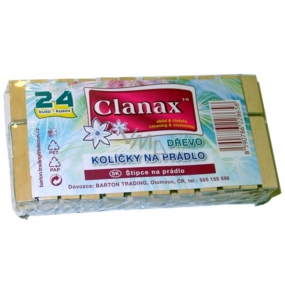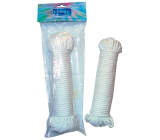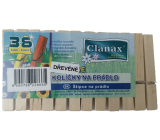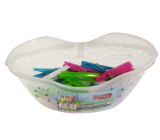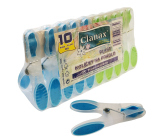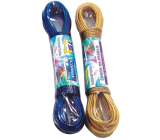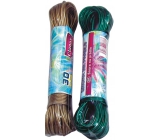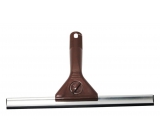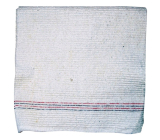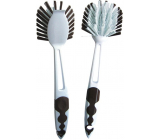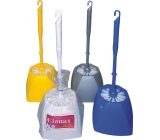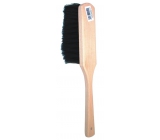Clanax Wooden Clothespins 24 pieces
| Code: | 21016 |
| EAN: | 8590786228658 |
| Producer: | dovozce: Bartoň Trading, s.r.o. |
| Brand: | Clanax® (web) |
 | |
Dřevěné kolíčky na prádlo - 24 kusů
Kolíček na prádlo, prádelní kolíček, kramlík, klamerka je drobná technická pomůcka používaná při sušení vypraného prádla. Slouží k přechodnému přichycení prádla a jiných textilií na prádelní šňůru během jeho sušení. V zásadě může být dvou různých typů.
Prádelní kolíček je tak velkou drobností, že si na něj majitelky elektrických sušiček možná stěží vzpomenou. Přitom jde o geniální nápad, který i přes mnoho redesignů zůstává v principu stále stejným, jednoduchým a elegantním pomocníkem v domácnosti.
The first shaped, wooden pegs originated in England. They were made from a single piece of flexible wood, usually Willow, by members of a Christian sect known as Quakers. They were known for their very simple lifestyle, whose daily routine included crafting durable wooden furniture and practical household items such as a clothes hanger or a laundry peg.
The Quakers were distinguished from other Christians by their charismatic, almost frenetic, spiritual expression, for which they were persecuted in their own country. In 1774, they left England and settled in America, where the pin was used unchanged until 1832, when the first patent for a wooden screw was registered. Although it did not prove very successful in practice, as the screw swelled and lost its functionality due to moisture, it took another twenty-one years before the prolific Vermont inventor David M. Smith patented a two-piece type with a metal spring.
By 1887, the U.S. Patent Office had issued 146 more certificates for variously modified pins, the design of which was refined into what we know today by Solon E. Moore.
Moore's version had the advantage that it was easy to mass produce and held well on the cord and in the wind. The first "peg factory" was established in Vermont and the tiny household helper was sold in large numbers all over the world.
After World War I, however, bad times came when goods from Europe flooded the market and American housewives began to prefer cheaper Swedish pegs and then even cheaper imports from China.
The domestic pin industry collapsed, and the nation's "pin manufactory" was forced to switch to plastic goods. Thus, the last American laundry pin rolled off the production line in 2009 to much media attention and patriot pity.
Over the course of 100 years, the humble, wooden clothes pin has undergone many changes, often for cosmetic reasons only. It has seen its ups and downs, survived the plastic boom and the advent of clothes dryers. But because of its usefulness, it has survived and is patiently waiting. Perhaps its time will return, burying the 1950s myth that electrical appliances can give us back our freedom. Perhaps there will come a time when drying laundry in the sun and fresh air will once again be commonplace, and clotheslines will no longer be considered aesthetically offensive.
This item has not been discussed yet. If you want to be first, click on the button Add a contribution
Dřevěné kolíčky na prádlo - 24 kusů
Kolíček na prádlo, prádelní kolíček, kramlík, klamerka je drobná technická pomůcka používaná při sušení vypraného prádla. Slouží k přechodnému přichycení prádla a jiných textilií na prádelní šňůru během jeho sušení. V zásadě může být dvou různých typů.
Prádelní kolíček je tak velkou drobností, že si na něj majitelky elektrických sušiček možná stěží vzpomenou. Přitom jde o geniální nápad, který i přes mnoho redesignů zůstává v principu stále stejným, jednoduchým a elegantním pomocníkem v domácnosti.
The first shaped, wooden pegs originated in England. They were made from a single piece of flexible wood, usually Willow, by members of a Christian sect known as Quakers. They were known for their very simple lifestyle, whose daily routine included crafting durable wooden furniture and practical household items such as a clothes hanger or a laundry peg.
The Quakers were distinguished from other Christians by their charismatic, almost frenetic, spiritual expression, for which they were persecuted in their own country. In 1774, they left England and settled in America, where the pin was used unchanged until 1832, when the first patent for a wooden screw was registered. Although it did not prove very successful in practice, as the screw swelled and lost its functionality due to moisture, it took another twenty-one years before the prolific Vermont inventor David M. Smith patented a two-piece type with a metal spring.
By 1887, the U.S. Patent Office had issued 146 more certificates for variously modified pins, the design of which was refined into what we know today by Solon E. Moore.
Moore's version had the advantage that it was easy to mass produce and held well on the cord and in the wind. The first "peg factory" was established in Vermont and the tiny household helper was sold in large numbers all over the world.
After World War I, however, bad times came when goods from Europe flooded the market and American housewives began to prefer cheaper Swedish pegs and then even cheaper imports from China.
The domestic pin industry collapsed, and the nation's "pin manufactory" was forced to switch to plastic goods. Thus, the last American laundry pin rolled off the production line in 2009 to much media attention and patriot pity.
Over the course of 100 years, the humble, wooden clothes pin has undergone many changes, often for cosmetic reasons only. It has seen its ups and downs, survived the plastic boom and the advent of clothes dryers. But because of its usefulness, it has survived and is patiently waiting. Perhaps its time will return, burying the 1950s myth that electrical appliances can give us back our freedom. Perhaps there will come a time when drying laundry in the sun and fresh air will once again be commonplace, and clotheslines will no longer be considered aesthetically offensive.
